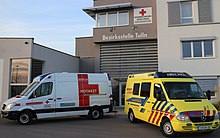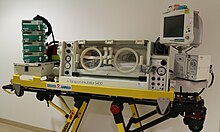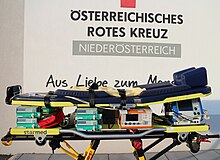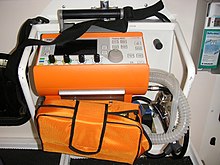Intensive care vehicle
|
Intensive care vehicle |
|
|---|---|
| Vehicle data
|
|
| Abbreviation: | ITW |
| Crew: | Emergency doctor, paramedic / paramedic, driver |
| Commitment: | Intensive transfer, return service |
| Furnishing: | DIN EN 1789 Type C: Mobile Intensive Care Unit
DIN 75076: 2012 intensive care vehicle (ITW) |
An intensive care vehicle ( ITW , also Mobile Intensive Care Unit MICU ) is an ambulance vehicle that is specially equipped to transport intensive care patients between intensive care units from hospital to hospital ( interhospital transfer ).
vehicles
As a minimum, ambulance vehicles should be used, but larger vehicles are often used than those used in the rescue service / emergency doctor service . Longer or truck chassis can serve as the basis for an ITW. According to requirements, these are equipped by body builders with, among other things, seats for the practitioners, cabinets for medical material, anchors for a stretcher and brackets for medical devices.
In some areas, experiments are being carried out with ITW vehicles that can be loaded directly with the hospital bed. It is hoped that this will save the patient the stressful repositioning processes. However, the space available in normal vehicles is significantly limited by the very wide hospital bed, making it difficult to care for the patient in the vehicle.
history
The history of intensive care transport cannot be precisely timed. However, there are case descriptions that go back to the founding period of the SAR (Search and Rescue) service of the German Armed Forces, which, albeit rarely, regulated the medically indicated transport of civilians as part of the so-called “urgent emergency aid”. The establishment of air rescue is also closely linked to the development of “doctor-accompanied secondary transport”. In June 1974, thanks to the support of the Björn Steiger Foundation, the first baby ambulance could go into service. This has to be mentioned in this context, because from the beginning both specially qualified staff and special vehicle extensions were used for this selected patient group. Even in the 80's intensive care patients, insofar as they existing logistics systems were completely transportable respect, using standardized standard life-saving equipment such as ambulances or emergency ambulance misplaced or ambulance helicopter under intensive care sometimes dubious circumstances. This has changed for the better in recent years, not least thanks to innovative medical and vehicle technology. Heart patients were another target group, which is why early intensive care vehicles were often referred to as so-called cardiomobiles. In 1987, the Arbeiter-Samariter-Bund was the first to start the interhospital transfer of intensive care patients. He developed a so-called intensive vehicle from a large-capacity bus. In addition, experiments were carried out with almost all chassis commonly used in the rescue service (including KTW MB high / long). The latter were left very quickly.
equipment
The larger interior offers more work space for the crew and makes it possible to accommodate the numerous additional intensive care devices that are carried along, which turn the vehicle into an intensive care unit on wheels.
The intensive ventilator deserves special mention here, as it enables differentiated ventilation patterns. Ventilators such as those used in intensive care units are used. If required, they can be operated using a battery pack and thus enable bed-to-bed transfers with continuous use. The devices have mobile compressed air and oxygen bottles for this purpose . Modern transport respirators are also used, but are not suitable for all patients. The emergency respirators usually used in the rescue service only serve as a back-up system in intensive care transport. In the vehicle, the ventilator can be operated via a 230 V generator that is connected to the motor shaft, or with the help of a voltage converter via the mains. Compressed air can be generated by modern ITW via a so-called air pump , a compressor , if required and stored in a compressed air tank in the vehicle.
In addition, an ITW has a monitor for monitoring the heart rate with a three (or twelve) channel ECG , the oxygen saturation of the blood via a pulse oximeter , options for non-invasive (NIBP) and invasive blood pressure measurement as well as for measuring the CVD . Capnometry and blood gas analysis (BGA) can also be used to monitor the effectiveness of ventilation. In some cases, NO nebulizers and so-called burn packs are also available for those with severe burns.
Otherwise, the typical equipment of a NAW, sometimes in larger quantities or with additional alternative products, is available: In addition to the intensive care ventilator, the vehicle has an emergency ventilator, twelve-channel ECG with integrated, optionally manual or semi-automatic defibrillator with pacemaker option , numerous syringe pumps , Scoop stretcher , vacuum mattress , etc. Of course, emergency cases are also on board. The equipment is designed for both adults and children. Transport incubators , which can be used to transfer seriously ill newborns, are also available at rescue stations or in clinics .
In addition, with these vehicles it is possible to continue to operate special intensive care devices during transport in order to ensure optimal patient care. These would be, for example, an intra-aortic balloon pump (IABP) or an extracorporeal membrane oxygenation (ECMO). For the transport of such devices, intensive care vehicles are usually equipped with an airliner profile for securing the medical technology and with a 230 V power supply.
staff
The crew consists of an experienced intensive care doctor with additional knowledge of emergency medicine (mostly anesthetist ), as well as a paramedic with the appropriate additional qualification (only in Germany) or an emergency paramedic . It should be noted that the terms emergency paramedic are not used identically in Germany and Austria. Many organizations employ people in intensive care who are also specialized health and nurses . Occasionally, intensive care transports are accompanied by cardio technicians . Another member of the rescue team is used as the "driver" . The ITW are often run by aid organizations . These often also provide non-medical medical staff. The doctors are usually provided by large hospitals, university clinics or academic teaching hospitals.
Calls
ITW are mainly used for transfer between hospitals. There are time-critical emergency relocations and planned secondary relocations. An ITW can be used for short distances when the use of an intensive care transport helicopter is not worthwhile, as well as for long distances when adequate care for the patient cannot be ensured during the flight or the helicopter cannot fly due to light or weather conditions.
Due to its equipment and the qualifications of the crew, the ITW can also be used as an ambulance. However, because of the longer lead times compared to regular emergency medical services, this option is used less often. Many ITW systems are part of the emergency services, depending on the legislation of the federal states (emergency service laws). You therefore also carry BOS radio with you.
costs
The costs of using an ITW are usually borne by the health insurance companies. In some federal states, applications have been made to include the intensive care vehicle in the ambulance service law. In Bavaria, the ITW operator is reimbursed for the operating costs through the Bavarian Rescue Association .
Locations
| city | country | operator | comment |
|---|---|---|---|
| augsburg |
|
German Red Cross | |
| Berlin |
|
Workers Samaritan Association | |
| Berlin |
|
armed forces | |
| Bremen |
|
Professional fire brigade | |
| Cambs near Schwerin |
|
German Red Cross | |
| Darmstadt |
|
Arbeiter-Samariter-Bund / German Red Cross | |
| Dusseldorf |
|
German Red Cross | |
| Eging at the lake |
|
IMS Rescue Service GmbH | |
| gain |
|
German Red Cross | |
| Fulda |
|
German Red Cross | |
| Goettingen |
|
Professional fire brigade / German Red Cross | Dual use |
| Hamelin |
|
German Red Cross | Dual use |
| Hamburg |
|
Workers Samaritan Association | |
| Hanover |
|
Professional fire brigade | |
| Hanover |
|
Johanniter Accident Aid | |
| Jena |
|
Intensive relocation service in Central Germany | |
| Karlsruhe |
|
German Red Cross | |
| kassel |
|
German Red Cross | |
| Kiel |
|
Workers Samaritan Association | |
| Koblenz |
|
German Red Cross / Bundeswehr | Occupied 2 weeks a month by the DRK, 2 weeks by the BW |
| Circle lip |
|
Johanniter Accident Aid | |
| Munich |
|
Workers Samaritan Association | The ASB operates 2 ITWs in Munich, Großhadern 70/20 and Neuperlach 70/20. |
| Muenster |
|
Workers Samaritan Association | |
| Neubrandenburg |
|
German Red Cross | |
| Oldenburg |
|
Johanniter Accident Aid | |
| Paderborn |
|
Maltese Aid Service | |
| regensburg |
|
German Red Cross | |
| Stuttgart |
|
Cooperation from JUH, ASB, DRK | |
| Ulm |
|
Cooperation from ASB, DRK | |
| Warendorf |
|
German Red Cross | |
| Wurzburg |
|
German Red Cross |
literature
- Andreas Thierbach, Johannes Veith: Practical Guide Interhospital Transfer. S & K-Verlag, 2005, ISBN 3-932750-95-0 .
- Uwe Hecker, Christoph Schramm: Practice of intensive care transport. Springer-Verlag, 2012, ISBN 978-3-642-21613-8 .






